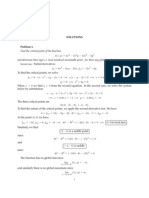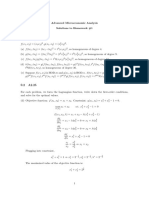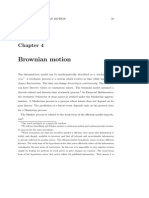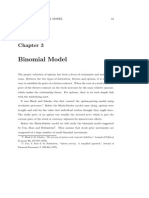Comparative Statics: 1 The Maximum Theorems
Comparative Statics: 1 The Maximum Theorems
Uploaded by
charles luisCopyright:
Available Formats
Comparative Statics: 1 The Maximum Theorems
Comparative Statics: 1 The Maximum Theorems
Uploaded by
charles luisOriginal Description:
Original Title
Copyright
Available Formats
Share this document
Did you find this document useful?
Is this content inappropriate?
Copyright:
Available Formats
Comparative Statics: 1 The Maximum Theorems
Comparative Statics: 1 The Maximum Theorems
Uploaded by
charles luisCopyright:
Available Formats
c 2001 Michael Carter
All rights reserved
Lecture notes based on
Foundations of Mathematical Economics
Comparative statics
1 The maximum theorems
max (x, )
x()
Let
() = max (x, )
() = arg max (x, )
x()
Objective
function
Constraint
correspondence
Value
function
Solution
correspondence
Monotone
maximum
theorem
Theorem 2.1
supermodular,
increasing
weakly
increasing
increasing
increasing
x()
Continuous
maximum
theorem
Theorem 2.3
continuous
Convex
maximum
theorem
Theorem 3.10
concave
Smooth
maximum
theorem
Theorem 6.1
smooth
continuous,
compact-valued
continuous
convex
compact-valued
nonempty, uhc
convex-valued
smooth
regular
locally
smooth
locally
smooth
2 The envelope theorems
2.1 Envelope theorem 1
() = max
(x, )
= (x (), )
so that
() = x
x
+
The rst-order conditions determining x are
x = x
concave
c 2001 Michael Carter
All rights reserved
Lecture notes based on
Foundations of Mathematical Economics
Moveover, x () satises the constraint as a identity
(x ()) = 0 = x
x
=0
Substituting, we conclude that
() =
Example 1 (Chip producer) It is characteristic of microchip production technology that a proportion of output is defective. Consider a small producer for
whom the price of good chips is xed. Suppose that proportion 1 of the
rms chips are defective and cannot be sold. Let () denote the rms total
cost function where is the number of chips (including defectives) produced.
Suppose that with experience, the yield of good chips increases. How does this
aect the rms production ? Does the rm compensate for the increased yield
by reducing production, or does it celebrate by increasing production?
The rms optimization problem is
() = max ()
= ( )
( )
() = +
= + ( ( ))
But the rst-order condition dening () is
( ) = 0
so that
() = > 0
Further, we can deduce that
() =
so that
()
()
()
=
0
since the prot function is convex.
c 2001 Michael Carter
All rights reserved
Lecture notes based on
Foundations of Mathematical Economics
2.2 Envelope theorem 2
() = max (x, )
()
= (x (), )
x
() = x
+
The rst-order conditions determining x are
x = x
Moveover, x () satises the constraint as a identity
(x (), ) = 0 = x
or
x
+ = 0
x
=
x
Substituting, we conclude that
() = =
Example 2 (Consumer problem)
(p, ) = max (x)
(1)
subject to p x =
(2)
= (x) (p x )
= =
= =
which leads immediately to Roys identity
x (p, )
Lecture notes based on
Foundations of Mathematical Economics
c 2001 Michael Carter
All rights reserved
2.3 Smooth envelope theorem (Corollary 6.1.1)
Assume that x0 is a strict local maximum of
max (x, )
x()
where () = { x : g(x, ) 0 }. By the smooth maximum theorem,
there exists a neighbourhood around 0 and function x such that
() = (x (), ) for every
and is dierentiable. Applying the chain rule
[] = x x +
indirect direct
What do we know of the indirect eect?
First If x is optimal, it must satisfy the Kuhn-Tucker conditions
x = 0 gx and 0 g(x, ) = 0
(3)
at (x0 , 0 ) where 0 is the unique Lagrange multiplier associated with
x0 .
Second The solution x () satises the constraint g(x (), ) = 0 for all
. Another application of the chain rule gives
gx x + g = 0 = 0 gx x = g
(4)
Using (3) and (4), the indirect eect is x x = 0 x x = g and therefore
[] = 0 g =
(5)
where denotes the Lagrangean (x, , ) = (x, ) g(x, ). This is the
envelope theorem, which states that the derivative of the value function
is equal to the partial derivative of the Lagrangean evaluated at the optimal
solution (x0 , 0 ).
In the special case in which the feasible set is independent of the parameters, g = 0 and (5) becomes
[] =
The indirect eect is zero, and the only impact on of a change in is the
direct eect f .
4
Lecture notes based on
Foundations of Mathematical Economics
c 2001 Michael Carter
All rights reserved
2.4 General envelope theorem (Theorem 6.2)
The assumptions required for Corollary 6.1.1 are stringent. Where the feasible set is independent of the parameters, a more general result can be given.
Let x be the solution correspondence of the constrained optimization problem
max (x, )
x
in which : is continuous and compact. Suppose that is
continuously dierentiable in , that is [x, ] is continuous in .
Then the value function
() = sup (x, )
is dierentiable wherever x is single-valued with [] = [x(), ].
Proof.
To simplify the proof, assume that x is single-valued for every
Then
() = (x (), ) for every
For any = 0
)
(
)
(
() ( 0 ) = x (), x ( 0 ), 0
)
(
)
(
x ( 0 ), x ( 0 ), 0
= [x ( 0 ), 0 ]( 0 ) + () 0
with () 0 as 0 . On the other hand, by the mean value theorem
(, 0 ) such that
(Theorem 4.1) there exist
)
(
)
(
() ( 0 ) = x (), x ( 0 ), 0
)
(
)
(
x (), x (), 0
0)
= [x (), ](
Letting 0
[x ( 0 ), 0 ]( 0 )
() ( 0 )
[x ( 0 ), 0 ]( 0 )
lim
lim
lim
0
0
0
0
0
0
is dierentiable (Exercise 4.3) and
[] = [x (), ]
where [x (), ] denotes the partial derivative of with respect to
holding x constant at x = x ().
5
c 2001 Michael Carter
All rights reserved
Lecture notes based on
Foundations of Mathematical Economics
Note that there is no requirement in Theorem 6.2 that is dierentiable with respect to the decision variables x, only with respect to the
parameters. The practical importance of dispensing with dierentiability with respect to x is that Theorem 6.2 applies even when the feasible
set is discrete (See Example 6.2).
()
(1 , )
(2 , )
(3 , )
3 Comparative statics of optimization models
There are four dierent approaches to comparative statics of optimization
models
Revealed preference approach
Envelope theorem approach
Monotone maximum theorem approach
Implicit function theorem approach
3.1 Revealed preference approach
A competitive rms optimization problem is to choose a feasible production
plan y to maximize total prot
max p y
y
Consequently, if y1 maximizes prot when prices are p1 , then
p1 y1 p y for every y
Similarly, if y2 maximizes prot when prices are p2 , then
p2 y2 p y for every y
6
c 2001 Michael Carter
All rights reserved
Lecture notes based on
Foundations of Mathematical Economics
In particular
p1 y1 p1 y2
and
p2 y2 p2 y1
Adding these inequalities
p1 y1 + p2 y2 p1 y2 + p2 y1
Rearranging
p2 (y2 y1 ) p1 (y2 y1 )
and therefore
(p2 p1 ) (y2 y1 ) 0
or
(1 2 )(2 2 ) 0
(6)
=1
If prices change from p1 to p2 , the optimal production plan must change in
such a way as to satisfy the inequality (6). For a change in the price of a
single good (2 = 1 for every = ), (6) implies that
(2 1 )(2 1) 0
or
2 > 1 = 2 1
3.2 The envelope theorem approach
Letting (y, p) = p y denote the objective function, the competitive rm
solves
max (y, p)
y
Note that is dierentiable with p [y, p] = y. Applying the envelope
theorem 6.2, the prot function
(p) = sup (y, p)
y
is dierentiable wherever the supply correspondence y is single-valued with
p [p] = p [y (p), p] = y (p)
or
(7)
y (p) = (p)
which is known as Hotellings lemma.
The practical signicance of Hotellings lemma is that, if we know the
prot function, we can calculate the supply function by straightforward
dierentiation instead of solving a constrained optimization problem.
7
c 2001 Michael Carter
All rights reserved
Lecture notes based on
Foundations of Mathematical Economics
Its theoretical signicance is more important. Hotellings lemma enables us to deduce the properties of the supply function y from the
already established properties of the prot function. In particular, we
know that the prot function is convex (Example 3.42).
From Hotellings lemma (7), we deduce that the derivative of the supply
function is equal to the second derivative of the prot function
y [p] = 2 [p]
or equivalently that the Jacobian of the supply function is equal to the Hessian of the prot function.
y (p) = (p)
Since is smooth and convex, its Hessian (p) is symmetric (Theorem 4.2)
and nonnegative denite (Proposition 4.1) for all p. Consequently, the Jacobian of the supply function y is also symmetric and nonnegative denite.
This implies for all goods and
[p] 0
[p] = [p]
Nonnegativity
Symmetry
In a similar fashion, we can deduce
Shephards lemma (Example 6.7)
Roys identity (Example 6.8)
From the latter, we can easily derive the Slutsky equation (Example 6.9).
3.3 The implicit function theorem approach
The rst-order conditions of an equality constrained optimization problem
constitute a system of equations.
(x; ) = 0
Provided the Jacobian (x [x; ]) of this system is non-singular, we can use
the implicit function theorem to solve for x in terms of . We illustrate by
means of an example.
Lecture notes based on
Foundations of Mathematical Economics
c 2001 Michael Carter
All rights reserved
Example Recall again the chip maker, whose optimization problem is
max ()
The rst-order and second-order conditions for prot maximization are
(, , ) = () = 0 and [, , ] = () < 0
The second-order condition requires increasing marginal cost. Assuming is
2 , the rst-order condition implicitly denes a function (). Dierentiating
the rst-order condition with respect to , we deduce that
= ()
or
()
which is positive by the second-order condition. An increase in yield is
analogous to an increase in product price , inducing an increase in output
.
Examples 6.15 and 6.16 apply the same technique to deduce the comparative statics of a competitive multi-input rm.
4 References
Milgrom, P., and I. Segal (2000), Envelope Theorems for Arbitrary
Choice Sets. Department of Economics, Stanford University: mimeo.
Silberberg, E. (1990), The Structure of Economics: A Mathematical
Analysis (2nd edition). New York, NY: McGraw-Hill.
c 2001 Michael Carter
All rights reserved
Lecture notes based on
Foundations of Mathematical Economics
5 Homework
1. Prove Proposition 5.2, that is if and g are 2 and [x ] is of full
rank, then the value function
(c) = sup{ (x) : g(x) = c }
is dierentiable with (c) = , where = (1 , 2 , . . . , ) are the
Lagrange multipliers associated with x .
2. Suppose that the cost function of a monopolist changes from 1 () to
2 () in such a way that
0 < 1 () < 2 () for every > 0
Let 1 denote the prot maximizing price with the cost function 1 ()
and let 1 be the corresponding output. Similarly let 2 and 2 be the
prot maximizing price and output when the costs are given by 2 ().
(a) Show that
2 (1 ) 2 (2 ) 1 (1 ) 1 (2 )
(8)
(b) The Fundamental Theorem of Calculus states: If () is a
continuous function on [a,b], then
()
() () =
Apply this to inequality (8) to deduce that 1 2 and therefore
that 1 2 .
(c) State concisely the proposition you have just proved.
3. Assume that a competitive rm produces a single output from
inputs x = (1 , 2 , . . . , ) according to the production function =
(x) so as to maximize prot
(w, ) = max (x) w x
x
Assume that there is a unique optimum for every and w. Show
that the input demand (w, ) and supply (w, ) functions have the
following properties:
[w, ] 0
[w, ] 0
[w, ] = [w, ]
[w, ] = [w, ]
10
Upward sloping supply
Downward sloping demand
Symmetry
Reciprocity
c 2001 Michael Carter
All rights reserved
Lecture notes based on
Foundations of Mathematical Economics
Solutions 7
1 The Lagrangean for this problem is
(
)
= (x) g(x) c
By Corollary 6.1.1
2
(c) = c =
(a) With cost function 1 (1 ), the rms prot is
= 1 ()
Since this is maximised at 1 and 1 (although the monopolist could
have sold 2 at price 2 )
1 1 1 (1 ) 2 2 1 (2 )
Rearranging
1 1 2 2 1 (1 ) 1 (2 )
Similarly
(1)
2 2 2 (2 ) 1 1 2 (1 )
which can be rearranged to yield
2 (1 ) 2 (2 ) 1 1 2 2
Combining the previous inequality with (1) yields
2 (1 ) 2 (2 ) 1 (1 ) 1 (2 )
(b) Applying the Fundamental Theorem of Calculus to both sides, this
implies
1
1
2 ()
1 ()
or
2 ()
2 ()
1 ()
1 ()
1
2
(2 () 1 ()) 0
0 for every (by assumption), this implies that
Since
2 1 . Assuming the demand curve is downward sloping, this implies
2 1 .
Lecture notes based on
Foundations of Mathematical Economics
c 2001 Michael Carter
All rights reserved
(c) There is an implicit requirement to utilize the Fundamental Theorem of
Calculus, namely that () is continuous. With this proviso, we have
shown that the monopoly price is increasing in marginal cost. Specifically we have shown: Assuming that a monopolists cost function is
continously dierentiable (in output), the prot maximizing monopoly
price is an increasing (i.e. nondecreasing) function of marginal cost.
3 By Theorem 6.2
w [w, ] = x and [w, ] =
and therefore
2
(, w) =
(, w) 0
(, w) = 2 (, w) 0
(, w) = 2 (, w) = (, w)
(, w) = 2 (, w) = (, w)
since is convex and therefore (w, ) is symmetric (Theorem 4.2) and
nonnegative denite (Proposition 4.1).
You might also like
- Analysis of "Smoke" by Mats EkDocument12 pagesAnalysis of "Smoke" by Mats Ekamber_heaven100% (2)
- Final Practice SolDocument11 pagesFinal Practice SolChris MoodyNo ratings yet
- Optimization Methods (MFE) : Elena PerazziDocument28 pagesOptimization Methods (MFE) : Elena Perazziddd huangNo ratings yet
- HW 4 CMDocument8 pagesHW 4 CMjaymart villartaNo ratings yet
- Calculus 7th Edition - Ch04Document78 pagesCalculus 7th Edition - Ch04يقين عبدالرحمنNo ratings yet
- EY Managing Bribery and Corruption Risk in The Oil and Gas Industry PDFDocument24 pagesEY Managing Bribery and Corruption Risk in The Oil and Gas Industry PDFNicolle HurtadoNo ratings yet
- Constraint QualificationDocument7 pagesConstraint QualificationWhattlial53No ratings yet
- 1 Concave and Convex FunctionsDocument12 pages1 Concave and Convex Functionscharles luisNo ratings yet
- Robert J. T. BellDocument79 pagesRobert J. T. BellAngshika DeyNo ratings yet
- Mathematics For Economics (Implicit Function Theorm)Document10 pagesMathematics For Economics (Implicit Function Theorm)ARUPARNA MAITYNo ratings yet
- Chap1 Lec1 Introduction To NLODocument3 pagesChap1 Lec1 Introduction To NLOUzair AslamNo ratings yet
- Summary Notes On Maximization: KC BorderDocument20 pagesSummary Notes On Maximization: KC BorderMiloje ĐukanovićNo ratings yet
- Octav Dragoi - Lagrange MultipliersDocument5 pagesOctav Dragoi - Lagrange MultipliersOctav DragoiNo ratings yet
- Lecture3 PDFDocument42 pagesLecture3 PDFAledavid Ale100% (1)
- Lecture NLP 1+updated+ (Part+2) PrintDocument49 pagesLecture NLP 1+updated+ (Part+2) PrintDurlav BanerjeeNo ratings yet
- Dynamic Programming 3 BellmanDocument8 pagesDynamic Programming 3 BellmanchuchomatNo ratings yet
- Bellman's Equations: T t+1 T T 0 T T t+1 T T, TDocument7 pagesBellman's Equations: T t+1 T T 0 T T t+1 T T, Tmunima23No ratings yet
- KKT PDFDocument4 pagesKKT PDFanirbanmbeNo ratings yet
- 1 Functions of Several VariablesDocument4 pages1 Functions of Several VariablesMohammedTalibNo ratings yet
- Notes 3Document8 pagesNotes 3Sriram BalasubramanianNo ratings yet
- Engineering Optimization: Methods and ApplicationsDocument49 pagesEngineering Optimization: Methods and Applicationsprasaad08No ratings yet
- Section 14.1 Functions of Several VariablesDocument6 pagesSection 14.1 Functions of Several VariablesAlvin AdityaNo ratings yet
- Dynamic Programming TechniqueDocument3 pagesDynamic Programming TechniqueVassim shahir.ANo ratings yet
- Hw1 2 SolutionsDocument7 pagesHw1 2 SolutionsFrancisco AlvesNo ratings yet
- Optimal Control TheoryDocument28 pagesOptimal Control TheoryDaniel WangNo ratings yet
- Solutions 9: Demo 1: KKT Conditions With Inequality ConstraintsDocument11 pagesSolutions 9: Demo 1: KKT Conditions With Inequality ConstraintsxAlexis19xNo ratings yet
- Dynamic Programming and Optimal Control 3rd Edition, Volume IIDocument233 pagesDynamic Programming and Optimal Control 3rd Edition, Volume IIVignesh RamkumarNo ratings yet
- Optimal Control Dynamic ProgrammingDocument18 pagesOptimal Control Dynamic ProgrammingPuloma DwibediNo ratings yet
- L17 Hyperbolic Functions PDFDocument14 pagesL17 Hyperbolic Functions PDFHey ShinnNo ratings yet
- Dynamic ProgrammingDocument36 pagesDynamic Programmingfatma-taherNo ratings yet
- Subgradients: Subgradient Calculus Duality and Optimality Conditions Directional DerivativeDocument39 pagesSubgradients: Subgradient Calculus Duality and Optimality Conditions Directional DerivativeDAVID MORANTENo ratings yet
- KorovkinDocument10 pagesKorovkinMurali KNo ratings yet
- MATH2023 Multivariable Calculus Chapter 3 Partial Derivatives L2/L3 (Fall 2019)Document36 pagesMATH2023 Multivariable Calculus Chapter 3 Partial Derivatives L2/L3 (Fall 2019)物理系小薯No ratings yet
- Optimal ControlDocument41 pagesOptimal ControlAdem BRITAHNo ratings yet
- Math For Econ (MIT)Document8 pagesMath For Econ (MIT)BorisTurkinNo ratings yet
- Definition of Hyperbolic FunctionsDocument7 pagesDefinition of Hyperbolic FunctionsKenny WilliamsNo ratings yet
- Applications of Partial Derivatives in EconomicsDocument6 pagesApplications of Partial Derivatives in Economicsshahzeb afridiNo ratings yet
- ECON6067 Topic 2 (I) 2022Document39 pagesECON6067 Topic 2 (I) 2022Mingtao ChenNo ratings yet
- MF007 Chapter 2 Differentiation Part IIDocument38 pagesMF007 Chapter 2 Differentiation Part IILionel MessiNo ratings yet
- Constrained OptimizationDocument6 pagesConstrained OptimizationMikeHuynhNo ratings yet
- Solutions To Problem Set 2: U U Is The Gradient of UDocument15 pagesSolutions To Problem Set 2: U U Is The Gradient of UWaqas Ahmad AwanNo ratings yet
- Advanced Microeconomics: Envelope TheoremDocument3 pagesAdvanced Microeconomics: Envelope TheoremTianxu ZhuNo ratings yet
- Chapter 2 Vector-Valued FunctionsDocument20 pagesChapter 2 Vector-Valued Functions物理系小薯No ratings yet
- Chapter 5 Multiple IntegralsDocument33 pagesChapter 5 Multiple Integrals物理系小薯No ratings yet
- R (X) P (X) Q (X) .: 1.7. Partial Fractions 32Document7 pagesR (X) P (X) Q (X) .: 1.7. Partial Fractions 32RonelAballaSauzaNo ratings yet
- 22-23 Vector Diferential Calculus Modified PDFDocument65 pages22-23 Vector Diferential Calculus Modified PDFAatharva ChaudhariNo ratings yet
- 2016 - June - P1.3 PDFDocument9 pages2016 - June - P1.3 PDFcris ye0% (1)
- Logarithmic DifferentiationDocument5 pagesLogarithmic Differentiationbhagya KhuntiaNo ratings yet
- Ps7 SolutionDocument6 pagesPs7 SolutionRagini ChaurasiaNo ratings yet
- Real Analysis - Homework Solutions: Chris Monico, May 2, 2013Document37 pagesReal Analysis - Homework Solutions: Chris Monico, May 2, 2013gustavoNo ratings yet
- Math523 5Document3 pagesMath523 5Rene BarreraNo ratings yet
- Learning Hessian Matrix PDFDocument100 pagesLearning Hessian Matrix PDFSirajus SalekinNo ratings yet
- 27 Principal Ideal Domains and Euclidean Rings: 1 1 K K I IDocument14 pages27 Principal Ideal Domains and Euclidean Rings: 1 1 K K I ISamraNo ratings yet
- A Functional Determinant For The Riemann Xi FunctionDocument12 pagesA Functional Determinant For The Riemann Xi FunctionJose Javier Garcia MoretaNo ratings yet
- Lecture 1 - Introduction To Differential EquationsDocument40 pagesLecture 1 - Introduction To Differential EquationsmatshonaNo ratings yet
- GEC220 Note Functions of Several Variables PDFDocument47 pagesGEC220 Note Functions of Several Variables PDFAbiola AjayiNo ratings yet
- Concave ProgrammingDocument10 pagesConcave Programmingcharles luisNo ratings yet
- Weak Maximum Principle For The Heat Equation: Tma4305 Pdes 2017Document4 pagesWeak Maximum Principle For The Heat Equation: Tma4305 Pdes 2017Nguyễn Thái DuyNo ratings yet
- A Mixed Finite Element Method For The Biharmonic Equation: ContentDocument9 pagesA Mixed Finite Element Method For The Biharmonic Equation: ContentVictor Pugliese ManotasNo ratings yet
- A-level Maths Revision: Cheeky Revision ShortcutsFrom EverandA-level Maths Revision: Cheeky Revision ShortcutsRating: 3.5 out of 5 stars3.5/5 (8)
- Mathematics 1St First Order Linear Differential Equations 2Nd Second Order Linear Differential Equations Laplace Fourier Bessel MathematicsFrom EverandMathematics 1St First Order Linear Differential Equations 2Nd Second Order Linear Differential Equations Laplace Fourier Bessel MathematicsNo ratings yet
- Consumption-Based Model and OverviewDocument31 pagesConsumption-Based Model and Overviewcharles luisNo ratings yet
- Kalton Schuman 1982Document33 pagesKalton Schuman 1982charles luisNo ratings yet
- Solutions To ExercisesDocument15 pagesSolutions To Exercisescharles luisNo ratings yet
- Exploring Black Holes Introduction To General RelativityDocument27 pagesExploring Black Holes Introduction To General Relativitycharles luisNo ratings yet
- Prerequisites - Welcome - TW3421x Courseware - EdXDocument2 pagesPrerequisites - Welcome - TW3421x Courseware - EdXcharles luisNo ratings yet
- References - Welcome - TW3421x Courseware - EdXDocument1 pageReferences - Welcome - TW3421x Courseware - EdXcharles luisNo ratings yet
- Queen'S University BelfastDocument8 pagesQueen'S University Belfastcharles luisNo ratings yet
- R Language - Welcome - TW3421x Courseware - EdXDocument2 pagesR Language - Welcome - TW3421x Courseware - EdXcharles luisNo ratings yet
- Introduction - Introduction - TW3421x Courseware - EdXDocument2 pagesIntroduction - Introduction - TW3421x Courseware - EdXcharles luisNo ratings yet
- Financial Mathematics: Myungshik KimDocument5 pagesFinancial Mathematics: Myungshik Kimcharles luisNo ratings yet
- Modification of Black-Scholes Model: 7.1 DividendDocument9 pagesModification of Black-Scholes Model: 7.1 Dividendcharles luisNo ratings yet
- One-Asset European Options: 6.1 Solution of The Black-Scholes EquationDocument15 pagesOne-Asset European Options: 6.1 Solution of The Black-Scholes Equationcharles luisNo ratings yet
- Interest Rate DerivativesDocument17 pagesInterest Rate Derivativescharles luisNo ratings yet
- Chap 4Document9 pagesChap 4charles luisNo ratings yet
- Chap 5Document3 pagesChap 5charles luisNo ratings yet
- Futures Market and Prices: 2.1 Warming UpDocument15 pagesFutures Market and Prices: 2.1 Warming Upcharles luisNo ratings yet
- Chap 3Document16 pagesChap 3charles luisNo ratings yet
- AMA 307: Financial Mathematics (Second Semester)Document1 pageAMA 307: Financial Mathematics (Second Semester)charles luisNo ratings yet
- Petroleum: Summary Statistics From Tables/Figures in This ChapterDocument24 pagesPetroleum: Summary Statistics From Tables/Figures in This Chaptercharles luisNo ratings yet
- Detection and Localization of Multiple Spoofing Attackers in Wireless Networks FAQ'sDocument2 pagesDetection and Localization of Multiple Spoofing Attackers in Wireless Networks FAQ'sPunith RaajNo ratings yet
- G5 Renewable EnergyDocument19 pagesG5 Renewable EnergyDan Gerico L. BacaniNo ratings yet
- We Are Gathering TogetherDocument1 pageWe Are Gathering TogetherAdeyemi JosephNo ratings yet
- Lesson 4 Manicure and PedicureDocument22 pagesLesson 4 Manicure and PedicureMARY JOY VILLARUEL100% (3)
- Case2: Liulishuo: AI English TeacherDocument3 pagesCase2: Liulishuo: AI English TeacherSoubhagya DashNo ratings yet
- Introduction To: PhytochemistryDocument39 pagesIntroduction To: PhytochemistryBem LimNo ratings yet
- Abap Sap 101 - Beginners - 2 - 04 - (PDF Document)Document4 pagesAbap Sap 101 - Beginners - 2 - 04 - (PDF Document)Kanigiri NareshNo ratings yet
- Activity #1 ReflectionDocument1 pageActivity #1 ReflectionIvy Claire Segundo TorresNo ratings yet
- Analysis of The Factors Affecting Customer PrefereDocument14 pagesAnalysis of The Factors Affecting Customer Prefere20uco648No ratings yet
- The Effects of Essence-Formed Cosmetic Ingredients Containing The GalactomycesDocument8 pagesThe Effects of Essence-Formed Cosmetic Ingredients Containing The GalactomycesLwsynergylab OfficialNo ratings yet
- 0perational Use of Ecdis Question SetDocument17 pages0perational Use of Ecdis Question SetAbu Syeed Md. Aurangzeb Al Masum100% (3)
- Agre D. Dichev D. Agre G.. Roman BalsamaDocument12 pagesAgre D. Dichev D. Agre G.. Roman BalsamaJana IvanovaNo ratings yet
- Svamitva - Guidelines - (2021-2025)Document102 pagesSvamitva - Guidelines - (2021-2025)sandeep kumarNo ratings yet
- B4 109 2014Document10 pagesB4 109 2014Yogesh OjhaNo ratings yet
- Ruin A Pratap ProblemsDocument118 pagesRuin A Pratap Problemstea777_ro4774No ratings yet
- Half Yearly Exam Session - 2018-19: Class - V Subject: ENGLISHDocument9 pagesHalf Yearly Exam Session - 2018-19: Class - V Subject: ENGLISHPrabhuNo ratings yet
- Nesbitt Stock Analyzer RequirementsDocument2 pagesNesbitt Stock Analyzer RequirementskamehouseNo ratings yet
- Bangalore/ChennaiDocument34 pagesBangalore/Chennaisai bNo ratings yet
- Homework 1Document3 pagesHomework 1Yeily Guzman CastroNo ratings yet
- Three Vignettes in Mixed StyleDocument29 pagesThree Vignettes in Mixed StyleavadhanulakNo ratings yet
- Teaching Grammar To Young LearnersDocument9 pagesTeaching Grammar To Young LearnersDado DodoNo ratings yet
- Jazz Improvisation - Essential Exercises, Technique, and Tips - MATT WARNOCK GUITARDocument42 pagesJazz Improvisation - Essential Exercises, Technique, and Tips - MATT WARNOCK GUITARleofds100% (1)
- A Qualitative Study On Life Adjustment of Working Student Who Are Experiencing PovertyDocument20 pagesA Qualitative Study On Life Adjustment of Working Student Who Are Experiencing PovertyDanica Ormeo IIINo ratings yet
- Biome Palettes GridDocument3 pagesBiome Palettes GridStephNo ratings yet
- Rmg88 62c2 Siemens ManualDocument21 pagesRmg88 62c2 Siemens ManualDaniel Pacheco100% (2)
- US Army WW2 - The Technical Services PDFDocument636 pagesUS Army WW2 - The Technical Services PDFDavid ChildersNo ratings yet
- NCSBN Learing Extention QuestionsDocument74 pagesNCSBN Learing Extention QuestionsYolanda Stark89% (18)
- Trainee's Record Book SWBLDocument12 pagesTrainee's Record Book SWBLaaronjules100% (2)












































































































